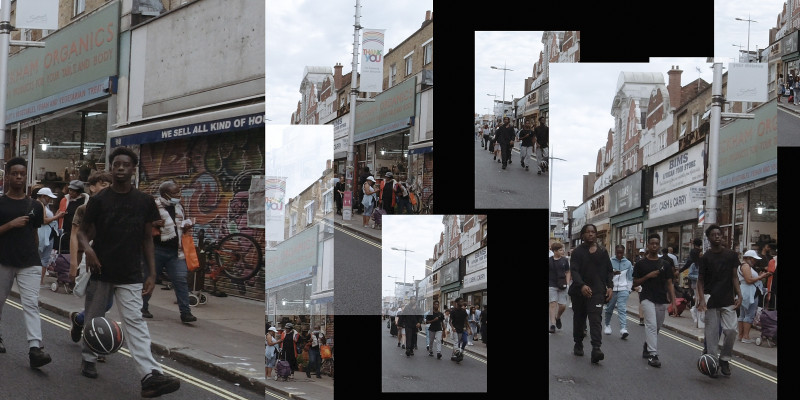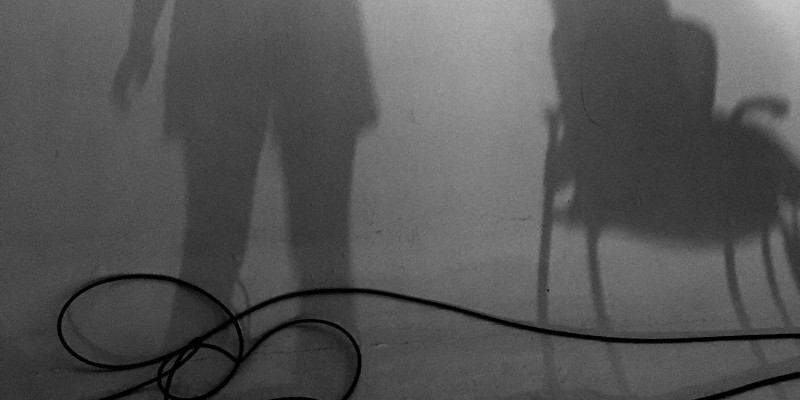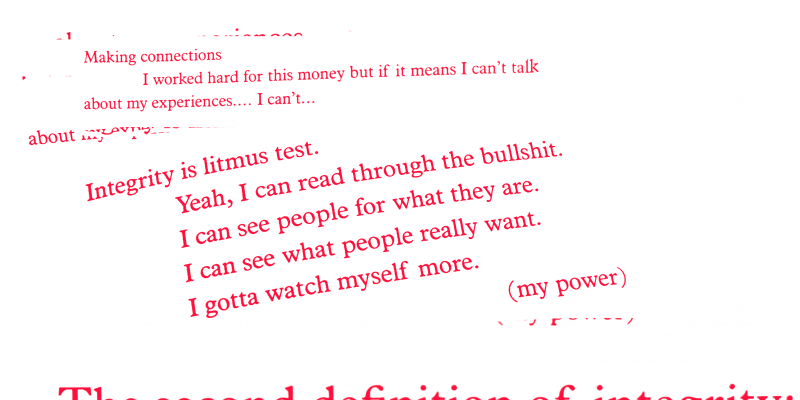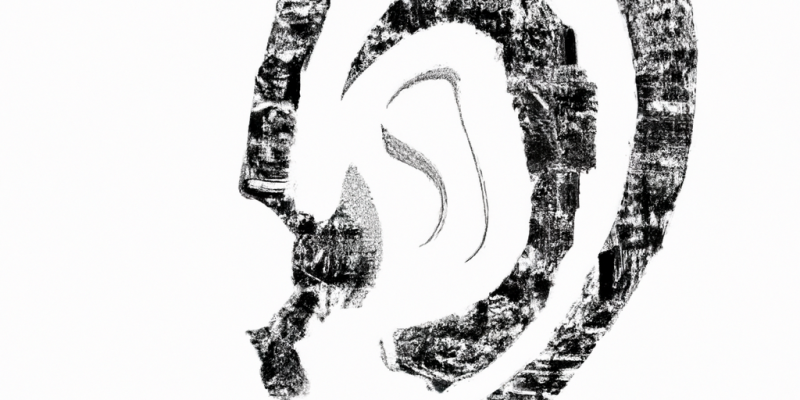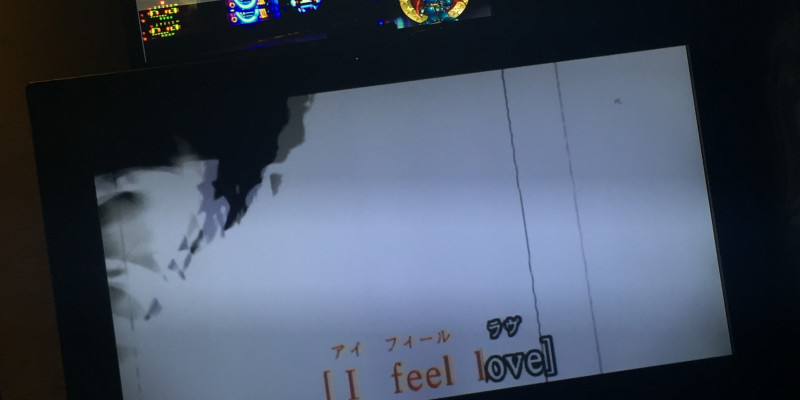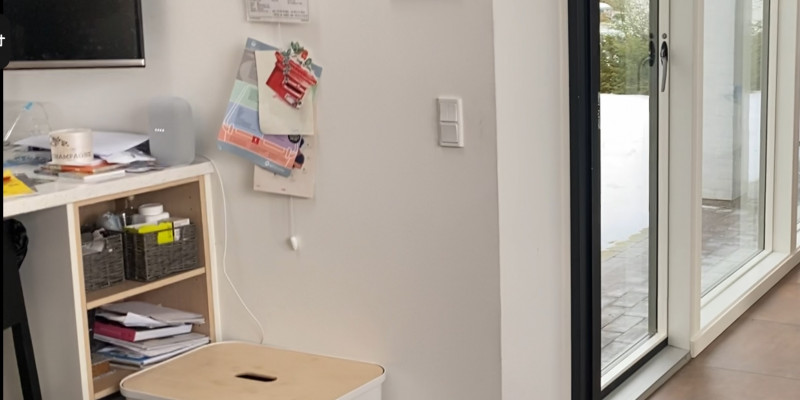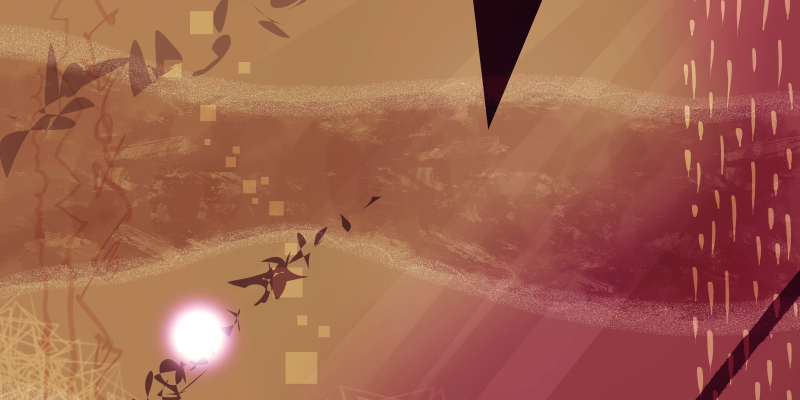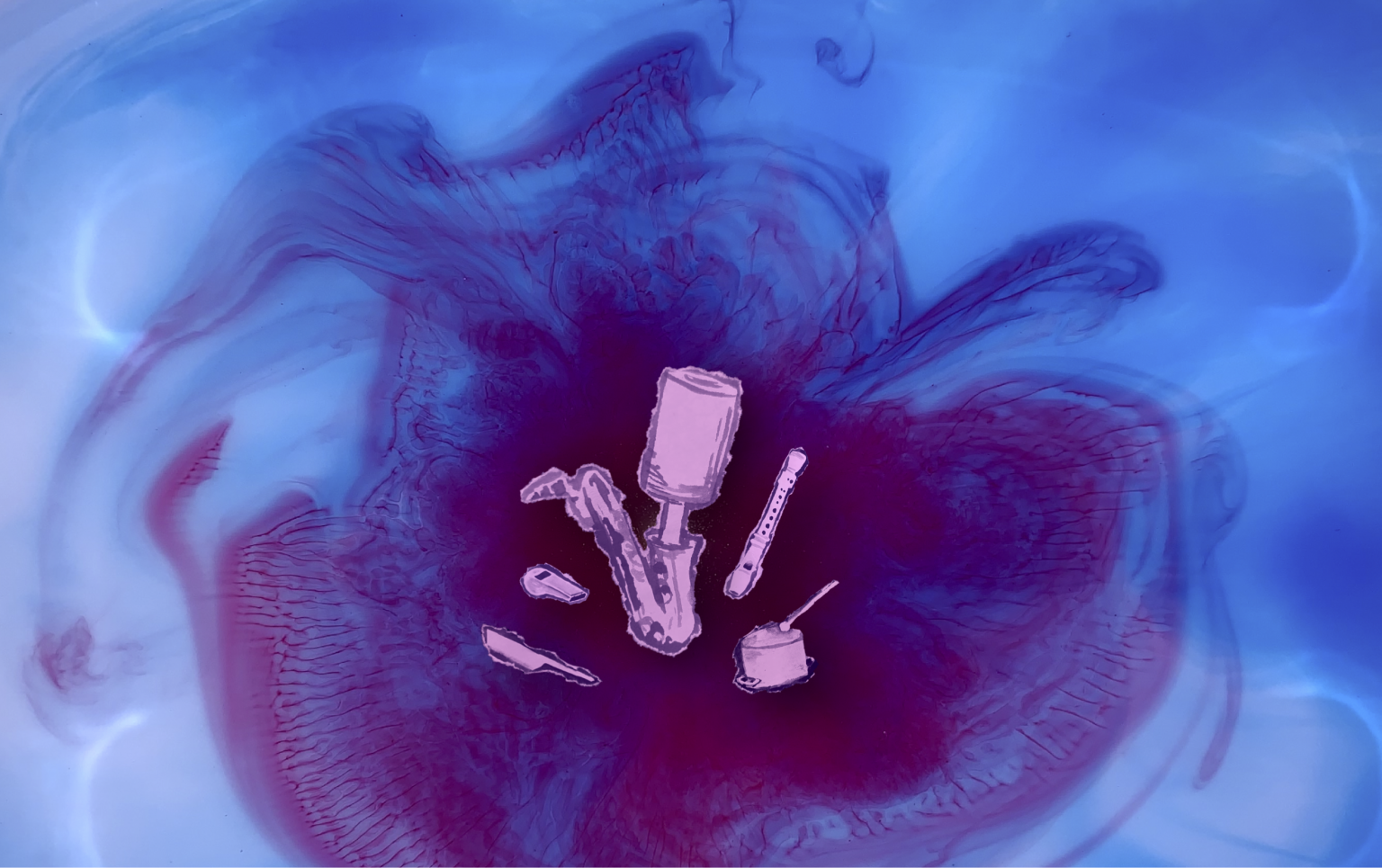
Democratic noise
Introduction
The sound of the people gathered in Kongens Have in Odense, Denmark, May 20th, 2020, is a jumble of noisy woodwinds, homemade percussion and the sharp, high pitch noise of small plastic whistles. Recognizable sounds of flutes and saxophones bring to mind associations of free jazz and avant-garde orchestras. Above all, this is a sound expression demanding attention. These people in the park are gathered under the collective term Free Jazz Mod Paludan (FJMP).1 Otto, one of the noisy protesters, explains:2 »The point [...] was just to make noise [...] to drown out Paludan.«3 (Otto-interview) Paludan refers to the Danish-Swedish far-right extremist Rasmus Paludan (*1982) who founded the political party Stram Kurs in 2017 and ran for the Danish parliament in 2019.4 With 1.8 percent of the votes, they were not elected. Paludan, however, got a lot of the election media coverage, especially in relation to his numerous Islamophobic demonstrations – often taking place in densely populated areas with a high percentage of residents with Muslim background and including actions such as burning the Quran. He was convicted under the racist discrimination law in 2020, but continued his demonstration activities, such as this one in May 2020, where he has showed up for the so-called »Draw Muhammad Day«.5
Not far from the FJMP crowd, he turns to another group of people standing around him: »Raise your hand if you can hear me!«6 A single person out of the many people who have turned up to the event raises his hand (Stram Kurs 2020, 2:15-2:28). During the next 50 minutes, however, the police orders FJMP to move away far enough so that those closest to Paludan can hear his Islamophobic statements and verbal racist harassment of a bystander (ibid., 14:10-15:00).
FJMP, which has been active since the spring of 2020, aims to "accompany racism-convicted Rasmus Paludan around the country with free jazz accompaniments and improvisations«7 (Om FJMP). This has materialized as a number of noise improvisations at several of Paludan's demonstrations across Denmark primarily in the period 2020-2022 by different volunteering participants – including our four informants.
Free Jazz Mod Paludan was initiated after jazz saxophonist Thorbjørn Øllgaard turned up at a Paludan demonstration in the beginning of May 2020 to drown him out with loud improvised saxophone playing. Subsequently, a Facebook page under the name »Free Jazz Mod Paludan« was created, where followers were invited to participate in noise improvisations when Paludan holds demonstrations. On the Facebook page, their actions are referred to as concerts and FJMP is described as »potentially Denmark’s biggest band«8 (Om FJMP). It is further stated that everyone can join, apart from Rasmus Paludan. A specific musical background is therefore not required to participate.
The situation in the park reflects the entanglement of music, improvisation and democracy, and Free Jazz Mod Paludan will serve as a case in this broader study of such entanglements. We will draw theoretically on social aesthetics and Jürgen Habermas' theory of democratic conversation, as well as on our empirical work in the form of interviews with Free Jazz Mod Paludan participants from the event in Odense, analysis of video material from the demonstration and social and other media commentary.
This is done to answer the key question of our study: How may democratic ideals be applied to collectively improvised music in a way that takes into account complex social realities? This calls for the following sub questions: What is the interrelationship between collectively improvised music and democratic conversation? In what way do they have pronounced similarities? How and why can collectively improvised music be discussed in terms of how democratic it is? And why does it make sense to apply the focus of what we call democratic potentiality here?
A democratic-communicative understanding of music
Below, we form the conceptual and theoretical basis of our case analysis of FJMP. Here, we introduce an understanding of music as communicative social interaction holding democratic potentials. We call this a democratic-communicative understanding of music. To conceptualize music in democratic terms, we draw on Habermas, whose theory links communication and democracy. However, as we shall return to, Habermas’ theory is narrowly focused on linguistic communication. We argue – and will unfold in the following – that this theoretical link is useful for communication in broader terms: We understand linguistic as well as musical communication not as a linear transmission of information from a sender through a medium to a receiver (Ashley 2017, 487; Miell et al. 2005, 3; Sawyer 2005, 57), but rather as a complex, emergent, processual and socially interactive meaning-making. Below, we elaborate how music may be understood this way.
Music as communicative social interaction
We understand music as practice – specifically as social interaction. We derive this understanding of music, and specifically improvisation, primarily from social aesthetics, as formulated in the anthology Improvisation and Social Aesthetics (2017). This understanding of music implies a rejection of a musicological prioritization of »music's notatable or scoreable parameters« (Born et al. 2017, 12) in favor of a focus on »the many ways in which our interactions with art participate in or serve an array of political orientations and social and cultural processes« (ibid., 3). To stress the meaning-making and communicative aspects of music, we furthermore take inspiration from an understanding within music psychology (see Trevarthen & Malloch 2000) of musicality not as a technical ability in terms of structured sound, but rather as having to do with »using sound and music to communicate with and form relationships to other people«9 (Ruud 2016, 52; see Cross 2006). In short, we understand music as specifically communicative social interaction.
Within social aesthetics, aesthetic objects are understood as being fundamentally social. Improvisation »cannot but empractise or manifest a social aesthetics« because »dialogical aesthetic practice is [...], immanently, a social interaction« (ibid., 10). Improvisation thus reflects and points to the social and not least dialogical character of music making. This becomes particularly evident in descriptions of improvisation such as these:
Group improvisation involves essentially dialogical engagements between the improvisers, so that they are compelled to communicate with one another, all parties receiving, negotiating, responding to, and attempting to create meaningful (musical or performance) utterances and gestures in real time. (Born et al. 2017,10 )
Since we are particularly interested, through Habermas’ theory, in the communicative aspects of music in order to link it to democracy, it therefore makes sense to take a particularly close look at collectively improvised music: Through its evidently dialogical characteristics, collectively improvised music makes particularly clear the communicative aspects of music.
In order to then discuss music in democratic terms, we use Jürgen Habermas to show that communication – and therefore also collectively improvised music – can be more or less democratic: Habermas presents a normative theoretical apparatus regarding democratic conversation which we will present below, where conversation ideals on a microsocial level in the form of his theory of communicative action are connected to the broader macro perspective in the form of his theory of deliberative democracy.11 In other words, he links communication and democracy. This is essential for discussing the democratic potentiality of collectively improvised music, making Habermas’ theory highly suited for our study.
HABERMAS' IDEALS OF DOMOCRATIC CONVERSATION IN A MUSICAL CONTEXT
Communicative action
In The Theory of Communicative Action Habermas establishes the concept of communicative action which is characterized by »an attitude oriented to reaching understanding« (Habermas 1984, 286), where individual »egocentric calculations of success« (ibid.) are subordinated to the shared wish of achieving a mutual agreement of what to be done in a given situation (ibid., 285ff). This should take place in a free, open and consensus-seeking dialogue (ibid., 17f) which Habermas calls the »ideal speech situation« (ibid., 42), where the goal is to reach a shared definition of the situation (ibid., 86), i.e., agreement. In case of disagreement, the agreement must be sought through open discussion and arguing – what Habermas calls a discourse (ibid., 18) – where it is crucial to »incorporate the other’s interpretation of the situation into one’s own« (ibid., 100), meaning to listen carefully and attentively, respect and verify one another’s diverging opinions.
Additionally, the open discourse ideally requires free and equal access to the conversation and that one
… excludes all force – whether it arises from within the process of reaching understanding itself or influences it from the outside – except the force of the better argument (and thus that it also excludes, on their part, all motives except that of a cooperative search for the truth). (ibid., 25)
Rational action is thus what is derived from the better argument, and its »peculiarly constraint-free force« (ibid., 24) is what solely decides the outcome of the discussion, which illustrates that the attitude to reaching understanding is dominant. Such a concept of excluding all force is inherently idealized, and we will return to how this must be taken into consideration when we apply Habermas to the case of FJMP.
We can thus sum up the Habermasian ideals as open discourse characterized by careful and attentive listening, in which a shared definition of the situation is achieved through seeking consensus based on the orientation to reach understanding, including a subordination of individual goals to the common. All of which has freedom from force and free and equal access to the conversation as a crucial precondition.
Even though Habermas in both his communicative and political theory leaves remarkably little room for discussion of the role of the aesthetic in general (Duvenage 2003, 2ff), in the following we unfold how his ideals can be applied to communication in a broader sense, and therefore collectively improvised music. This will constitute the theoretical basis of our analysis of the democratic potentiality of FJMP. Firstly, we show how the above-mentioned ideals of communication can be applied in a micro-social, collectively improvised musical performance.
First and foremost, the Habermasian discourse as an ideal way of communicating is not far from what is potentially at stake when it comes to improvisation:
Each member of the ensemble constantly suggests new musical [ideas] [...] and [...] each musician's new idea is subject to a social process of evaluation[...]. They collectively have the option of accepting the idea (by working with it, building on it, making it ‘their own’), rejecting it (by continuing the performance as if it had never occurred), or partially accepting it (by selecting one aspect of it to build on, and ignoring the rest). (Sawyer 2005, 55)
We thus juxtapose the musical process where every musician contributes individually in an improvisation, and at the same time is constantly taking part in deciding how each contribution is to shape the overall improvisation with the Habermasian discourse. We call this a collective process of evaluation. Habermas’ accentuation of attentive and careful listening in the discourse is also present in improvisation: When several elements are spontaneously decided in the process of evaluation, the resulting unpredictability (ibid., 48; Vuust & Kringelbach 2017, 272; Monson 1996, 26f) necessitates attentive and careful listening.
Furthermore, we juxtapose Habermas’ ideal of shared definition of the situation – agreement – with the fact that improvisers, like the ones participating in FJMP, when improvising are creating meaning together. We call this collective sense-making. The outcome of the improvisation can be described as a “collaborative emergence” (Sawyer 2005, 49), where meaning is created through “participatory sense-making” (Schiavio & De Jaegher 2017, 31). This is illustrated by the fact that the individual alone cannot decide and neither beforehand determine the meaning of an improvisation: »The eventual musical meaning of an improvised phrase is determined by a collaborative, emergent process« (Sawyer 2005, 48f).
Habermas’ ideal of orientation to reach understanding, including the seeking of consensus and the subordination of individual goals to the common, can be juxtaposed with the processes where social attitudes are promoted and/or increased through musicking with others. This may include increased intersubjectivity (Stupacher 2019, 19) and »merged subjectivity« (Rabinowitch et al. 2012, 118), empathizing (Laurence 2017, 17; Ashley 2017, 486; Gebauer & Vuust 2014, 23; Cross et al. 2012, 339) and social connectivity (Gebauer & Vuust 2014, 23). It may also include prosocial behavior (Stupacher et al. 2017a&b) and willingness to collaborate (Stupacher 2019, 18; Cason et al. 2017, 308; Cirelli et al. 2014, 1) which is reflected in a number of studies (cf. Cason et al. 2017, 308; see Hallam 2015) including several behavioral and neuroscientific studies (Clarke 2017, 198f). In other words: Just like participants in a conversation may orient themselves towards understanding one another, similarly, may improvisers. However, in a non-linguistic context, this may easier be understood as not necessarily linguistically expressed, and sometimes entirely pre-lingual social processes like the above-mentioned. We in short and collectively refer to these as social attitudes.
Finally, as opposed to rephrasing the Habermasian ideals to fit a musical context such as FJMP, as was necessary for the previously mentioned ideals, we retain Habermas’ phrasing of the ideals of freedom from force and free and equal access, since these concepts are just as useful for improvisations. When these are understood as social communicative interactions it is self-evident from a social aesthetics perspective that they are deeply rooted in relations of power and the related creation of inequality (Born 2017, 46; Monson 2017, 82). Improvisations may therefore – as we will likewise discuss for the case of FJMP – be more or less characterized by (a lack of) freedom from force, as well as (a lack of) free and equal access - like any other social interaction.
This shall be elaborated further later since this concerns and is highly entangled with complex social contexts on the meso- and macro-levels.
As illustrated above, democratic ideals may be applied to collectively improvised music on a microsocial level. This calls for a new way of thinking. Both when we assess improvisations – as will be evident in our analysis of FJMP – and when we e.g. initiate, facilitate or participate in collectively improvised music performances. From a democratic-communicative understanding of such improvisations, we may well ask: Is everyone participating in shaping this improvisation through actually and actively listening to each other’s contributions? Is everyone participating collaboratively in creating the musical meaning of this improvisation? Are participants actually understanding – or bonding, connecting and empathizing with one another? And, most importantly – considering power relations and questions of access – why or why not?
Deliberative democracy
As illustrated, the ideals of communicative action on a micro-social level can be applied to collectively improvised musical performances, and in Between Facts and Norms Habermas links communicative action to his theory of deliberative democracy which takes place on »the social level of institutionalized processes of deliberation and decision making« (Habermas 1996, 461f). This link is particularly relevant due to our focus on democratic conversation.
Habermas’ deliberative understanding of democracy implies that democratic legitimacy is rooted in public deliberations, i.e. common reflexive attempts to communicatively solve problems of coordination and thus create a collective will-formation. The discourse which on this macro-social level is public and involves all citizens plays a key role when it comes to whether a democratic decision can be considered legitimate (ibid., 110f; 130f). Thus, to Habermas, the ideals of the micro-social communication are also crucial to democratic legitimacy in a wider macro-sociality.
Just as in the case of the micro-social communicative action, music can also be integrated into this way of viewing public deliberations. According to Torgeir U. Nærland, Habermas himself gives examples of how his idea of public deliberation contains a possibility for an expressive, aesthetic communication to play a role (Nærland 2015, 40f; 50f). Firstly in The Theory of Communicative Action where it is stated that “[a] work validated through aesthetic experience can then in turn take the place of an argument” (Habermas 1984, 20) if it is verbalized and thus able to take part in a rational discourse. Secondly in Between Facts and Norms where he mentions that the public must »amplify the pressure of problems, […] convincingly and influentially thematize them, […] and dramatize them in such a way that they are taken up […] by parliamentary complexes« (Habermas 1996, 359). We argue that the aesthetic, including music, has particularly evident potentials to do exactly that. To thematize and dramatize problems in a way that offers a valuable contribution to the public deliberation. As we will later show, this is very evident for the case of FJMP.
In sum, Habermas’ theory of communicative action presents ideals for communication, which can be applied to collectively improvised music on a micro-social level. By including these ideals of communication in his theory of deliberative democracy, he establishes a link between communication and democracy, which we use as a basis to assess and discuss communication, including collectively improvised music, as more or less democratic, and how it can contribute to the deliberation on meso- and macro-level.
Potentiality as an alternative to idealization
When using Habermas' theory, it is crucial to be aware of the fact that its ideals cannot necessarily be realized. The ideal speech situation's goal of »stable and unambiguous[...]« (Habermas 1984, 100) agreement and a shared definition of the situation must more often than not be reassessed and constantly reinterpreted and negotiated through ongoing discourses. Likewise, the deliberative ideal of democracy is challenged by both transversal purposive-rational political self-interests (Habermas 1996, 155ff) and the lack of a unified public (Eriksen et al. 2003, 273).
In addition, Habermas points out that a realization of these ideals requires, and is constituted by, an interaction with institutionalized processes. For example, that the state constitutionally ensures free and equal rights for all citizens, so that they are able to participate in the discursive process, the deliberation, on equal terms (ibid.) – cf. the ideal of freedom from force and free and equal access to the conversation.
When applying the Habermasian ideals to a musical context it is thus crucial that the starting point for the investigation does not remain on an ideal level, as the investigation would then ignore – and thus tacitly accept - that social realities are rarely, if ever, ideal. In this context, social aesthetics implies a critique of theories that are »blind to [...] such social relations as those pertaining to class, race, ethnicity, religion, gender, sexuality, or nationality, and the histories and power relations in which they are entwined« (Born et al. 2017, 2). Georgina Born emphasizes directly: »Thus, rather than conceive of social relations in a pluralistic world as [...] oriented to consensus or community, we should address them as constituted equally by difference, as well as by agonism and antagonism« (Born 2017, 46). In continuation of our main research question, the question therefore becomes: How can Habermas' theory – which orients itself towards ideals of common goals and consensus seeking – be applied in a context of music, without disregarding the fact that social realities – rather than being characterized by free and equal rights for all citizens – can be said to be "heterogeneous, contentious, troubling, and unresolved« (ibid., 56) and determined by power relations (ibid., 46; Monson 2017, 82).
Rather than remaining on an ideal level – or applying ideals directly to social realities – we propose taking as a starting point an understanding that improvisation has Habermasian potentials. To take potentiality as a starting point means, on the one hand, to recognize and take seriously that the social realities of improvisation are not ideal, which is why the ideals are not inherent or automatically fulfilled. And on the other to insist on looking towards agency and possibilities for changing these non-ideal social realities: to work with the democratic potentials of improvisation.
THE DEMOCRATIC POTENTIALITY OF FREE JAZZ MOD PALUDAN
Three levels of sociality as an analytical framework
Our approach in the following analysis of FJMP is thus based in the democratic-communicative understanding of music and the way it implies that music can be examined based on a focus on such democratic potentiality and how it materializes.
An essential foundation for such an investigation is that the analysis must take into account three different levels of sociality: Micro, meso and macro.12 Nicholas Cook points to the often seen tendency to assume that any positive social effects of a given musical microsocial interaction (such as a collective improvisation) can be transferred directly to wider levels of sociality. However, this is an idealizing fallacy and far from always the case (Cook 2017, 74f). Through the division of the analysis into the three levels, we aim to avoid such idealization. And as will become clear, the outcome of the analysis of FJMP confirms that the assessment of the democratic potentiality of a given musical practice can vary depending on which level of sociality is analyzed.
On the micro-social level of the analysis, the micro-sociality that a given improvisation assembles is examined. Micro-socialities are understood as situated human interactions such as (in a music perspective) musical performances (cf. Born et al. 2017, 13; Cook 2017, 75; Monson 2017, 81) – for example a free jazz ensemble improvising with each other in, for example, a rehearsal room or on a stage.
We understand meso-socialities in a musical context as locally rooted communities assembled by such micro-social musical performances, for example the partly situated and temporary, partly imagined community at a local music venue. In addition to assembling such musical socialities, music can also influence and be influenced (especially the latter) by existing socialities. Thus, we view the meso-social communicative interaction in the case of FJMP as constituted by a triadic relationship between FJMP, Paludan/Stram Kurs and the bystanders.
We understand macro-socialities as the larger social contexts in which music is embedded. With our specifically Habermasian starting point, we look primarily at the totality of a public deliberation, which is necessarily imagined (cf. Benedict Anderson, 1983).
Accepting the differences between the levels, the analysis must additionally take into account the interdependency of the three levels of sociality.
The empirical basis of the analysis
Our case analysis of FJMP is based on empirical work done in the period of October 2020 to January 2021. We were methodologically limited by the fact that FJMP did not attend any Paludan-demonstrations in the period, and we were therefore prevented from doing for instance participatory observations. Instead, we conducted four qualitative, semi-structured interviews with the informants Jens, Otto, Andreas and Mads after them all taking part in FJMP at the same demonstration in Odense on the 20th of May 2020.13 This demonstration was one among several demonstrations in Danish cities in connection with the nationwide event »Draw Muhammad Day«, which was initiated and organized by Rasmus Paludan and Stram Kurs.
The four informants were aged 17-24 and all in different ways part of the environment around Musikalsk Grundkursus (MGK), in Odense. While FJMP is usually constituted by participants from various backgrounds in terms of technical musical skill level, our informants are all examples of participants with a relatively high degree of musical training.
The informants' respective background for participating in the demonstration is a good example of FJMP's word-of-mouth mobilization. Mads, who attended MGK, was contacted by FJMP's founder Thorbjørn Øllgaard via a mutual acquaintance, offering to coordinate the recruitment of participants for the demonstration in Odense. He invited i.a. his roomie Andreas (also an MGK student), who subsequently spread the word in his amateur big band, of which Jens was a part. Jens also asked a number of his musician friends, including Otto, if they wanted to join the demonstration. While Jens and Mads were already part of an activist, left-wing environment in Odense, it was the first time for both Andreas and Otto that they participated in a demonstration.
In our interviews, we asked e.g. how the informants had become aware of FJMP, why they chose to participate in the demonstration, what happened before, during and after the demonstration and their experience of participating in it as well as their general thoughts about and attitude towards both FJMP and Rasmus Paludan.
The concrete experiences along with considerations and ideas of the event and FJMP of the informants are thus an important part of our empirical material. In order to include the perspective of Paludan and Stram Kurs, we reached out to him and several members of Stram Kurs, who were present at »Draw Muhammad Day« in Odense,14 but unfortunately, none of them wished to take part in an interview. However, we have been able to use Stram Kurs’ Facebook-livestream video of the 45 minutes Paludan was present at the demonstration in Odense. In addition to that, we have used content from the Facebook-page of FJMP along with articles and interviews about FJMP as supplementary empirical material.
Micro-social level: Making noise together
Based on our empirical material and the new way of thinking about improvisations in terms of democratic ideals, which we developed above, we analyze and discuss the democratic potentiality of FJMP – firstly, on the micro-social level. We understand this as the situated interaction between the participants in FJMP in Kongens Have in Odense on 20 May 2020.
Our analysis shows that a collective process of evaluation was expressed to a small degree in FJMP's improvisation. This is illustrated particularly clearly by Otto’s experience:
»then I honestly started to get a little bored along the way. [...]. And then I realized that [...] you could also just do warm up and exercises and stuff like that. So, I just played scales and chords to get the hang of it, you might as well spend the time doing that« (Otto interview).15
The analysis thus shows, on a micro-social level, that the potential for a collective process of evaluation was not immediately fulfilled. The participants therefore risked disregarding the contributions of fellow improvisers, and as a result making contributions to the noise improvisation that bothered or disturbed fellow improvisers, which was – as we shall return to – not their intended outcome. The lack of a collective process of evaluation was connected, among other things, to the fact that the participants did not necessarily experience this improvisation as »music«, but rather as »just noise« (Jens interview; Otto interview; Andreas interview).16 This led them to engage less in active listening and in evaluating musical contributions. However, it would be one-sided to write off the Habermasian potential of noise on that basis.
The noise turned out to be crucial to the collective sense-making. In this case, Otto’s contribution was not necessarily included in an ideal collective process of evaluation – but it became part of a collective sense-making of and through noise. As Jens picturesquely puts it, it was »a golden thread of individual noise« (Jens interview).17 Thus, noise became a common goal and message. Mads explains: »it was meant to sound bad, you know« (Mads interview).18 In other words, even though a contribution such as Otto’s scale practice was not necessarily created on the basis of an active evaluation and listening to the other improvisers, by virtue of the common goal of creating noise, that contribution was still a way of participating collaboratively in creating a collective musical meaning.
This likewise allowed for a high degree of social attitudes in the improvisation: The participants describes a pronounced and crucial experience of creating noise together. This is reflected in Otto’s experience of »a great sense of community« (Otto interview).19 Jens also describes the experience in the interview as an attitude of »okay, now we're just going to make noise, and it sounds terrible. But we just make noise. And we are all doing it together« (Jens interview).20 It thus seems from our informants’ expressions of their experiences that they socially bonded and connected with their fellow improvisers.
By virtue of the unifying message of making noise, everyone could individually contribute to the »golden thread of noise«, each in their own, different ways. The noise improvisation thus realized a particular potential for giving people free and equal access to participation across musical instrument skills and ownership, as contributions across all technical skills were included in the improvisation. Jens describes it like this: »[People] had brought all sorts of funny instruments, all sorts of home-made like ‘rumsterstang’-like,21 strange things (…), all sorts of crazy things.«22 He also emphasizes how it was an especially important part of the experience that people were simply there and »were involved« (Jens interview).23 This was regardless of the fact that louder instruments could seem to have a greater influence in the improvisation than others (Jens interview). Seen specifically on a micro-social level, and specifically when it comes to technical skill level, FJMP's improvisation fulfills the potentials for freedom from force and free and equal access to a particularly high degree since the unifying message of noise proved to give wide access to the improvisation. However, these ideals are deeply rooted in wider social contexts that are inevitably influenced by power relations, which is worth acknowledging. For instance, the question of access within the situated improvisation of the participants present cannot be separated from the question of who gained access to participate in the first place, e.g. across intersectional categories. Since such questions regard the meso- and macrosocial level as well, we shall return to this, in particular regarding the context of the marginalization of Muslims (Voyer & Lund 2020, 339) and the risks for racialized people to participate in an improvisation taking place at one of Paludan’s demonstrations.
When we apply democratic ideals to a real, situated improvisation such as FJMP’s in May 2020, the complexity of social realities becomes particularly clear: Sometimes, the fulfillment of a democratic potential is at the expense of others; sometimes, they seem impossible to fulfill at all – as would be the case for actual all-encompassing free and equal access and freedom from force. Simultaneously, the experiences of FJMP participants make evident that democratic ideals are worth pursuing: When we assess or participate in improvisations, it is worth keeping in mind that, on a microsocial level, there are actual potentials for example to create a common goal and meaning, a sense of community and the ability of people across technical skill-level to participate.
Meso-social level: Noise as weapon or shield?
In the analysis on a meso-social level, we identify two different interpretations of the purpose of FJMP. In the first interpretation, FJMP is negatively defined as an attack against Paludan. Whereas the use of noise might have including and Habermasian potentials in the micro-social communicative interaction, in the meso-social, the noise seems to be more excluding than including, since it is used as a (sonic) physical weapon, so to speak, aimed at Paludan. Numerous critical studies have increasingly pointed out the violent and/or destructive potentials of music and noise (see Cusick 2008a; Cusick 2008b; Goodman 2010, 190; LaBelle 2020, 27; 73f; 213). In a free jazz context, Zachary Wallmark shows how the use of “the saxophonic scream” in the free jazz of the 1960s can be viewed both as an authentic expression of pain and anger, but also as a potentially alienating and aggressive attack on the listener (Wallmark 2016, 239). FJMP actively and distinctly draws on such potentials of »the saxophonic scream«, when they for instance explicitly try to recruit loud wind instruments (FJMP 2020a).
It is evident that Paludan also experiences the sound of FJMP in this way. As can be seen in Stram Kurs’ livestream video from the demonstration in Odense, he is both bodily and verbally showing obvious irritation and discomfort from the sound of FJMP and is asking the police to remove them (Stram Kurs 2020, 1:40-7:42) – reactions that recur in videos from other demonstrations (Øxenholt Foto & TV 2020, 0:18-0:52). In addition, he declares to Vice World News that »they [FJMP] can only make noise« (Andersen 2020). Seen exclusively from the perspective of this meso-social interpretation of purpose, FJMP does not fulfill the Habermasian ideal of a deliberation with free and equal access, where everybody is being heard, since their purpose literally is to drown out Paludan’s speech with their noise. Additionally, they state in their group rules on Facebook, that they will not »start discussions with idiots« (Grupperegler FJMP).24 We will return to how this way of drowning out Paludan can be understood in a wider democratic conversation when we turn to the macro-social level.
On this meso-social level, we also see an aversion from Paludan to recognize and listen to the perspective of the counterpart, when he at the demonstration states that:
What you typically do, when you have no arguments in a democracy, is that you make noise like a monkey. And over there you can see a lot of people, who have no arguments against our policies, and therefore they are only able to make noise like, like animals (Stram Kurs 2020, 6:38-6:52).25
This mutual lack of orientation to reach understanding from both parties in the deliberation means that the communicative interaction taking place between FJMP and Paludan, when analyzed specifically from this meso-social interpretation of purpose, does not fulfill the Habermasian ideals of democratic conversation, but rather the opposite.
The second interpretation of purpose that can be identified in our empirical material offers a supplementary perspective to the assessment on the meso-social level. In this FJMP is perceived as a protection of a third actor in the meso-social communicative action in the form of the bystanders – especially those verbally attacked by Paludan. A recurring characteristic of Paludan's demonstrations is his practice of hate speech and verbal assault of Muslim bystanders. Often with the deliberate aim of provoking a physically violent backlash to be filmed by Paludan's far right activists and distributed on social media with the purpose of »justifying exclusionary far right aims such as punishment and deportations of racialized minorities« (Switzer and Beauduin 2023, 1336).
This interpretation of FJMP as protection is highly present in the reasons the informants give for their participation: to show their sympathy with these Muslim bystanders, and to ensure that Paludan’s messages were not left unchallenged.
This is also embedded in the wider macro-social context of marginalization of Muslims in which Paludan takes part. Iram Khawaja et al. describe how he represents a radicalized and extremist expression of the far-right nationalist deglobalizing political rhetoric that has been increasing in the Danish political landscape over the last 20 years. Among other things, this tendency has manifested itself in numerous tightening of refugee and integration legislation, especially in relation to immigrants from what are often referred to as »non-Western« countries (Khawaja et al. 2023, 249f; 252f). In continuation of this connection, Khawaja et al. show how the result of Paludan's rhetoric and actions is dehumanization and racialization – not only on a macro-social level, but also on a more local meso-social level in connection with his demonstrations, e.g. through hate speech and verbal assault of Muslim bystanders (ibid., 254f).
According to Andreas, FJMP are playing for these bystanders and not Paludan (Andreas interview). Through this interpretation, FJMP can thus be seen as a way to ensure a group (those who disagree with and are attacked by Paludan) a voice in the deliberation. A voice Paludan im- and explicitly through his dehumanization seeks to deprive them of.
To summarize, the meso-social level holds democratic potentials for orientation to reach understanding, which are far from fulfilled in the interaction between Paludan and FJMP. Simultaneously, the meso-social level involves bystanders as a third actor that ideally should be given a voice in the deliberation. By including this perspective, FJMP’s contribution to the democratic conversation must thus be considered in a more positive light than if solely considering the first interpretation. These simultaneously existing assessments illustrates that the realities, as previously mentioned, are more complex than Habermas' ideals.
Macro-social level: Disarming bullshit
To assess FJMP's participation in the public deliberation on a macro-social level, Paludan's general actions in this deliberation must be taken into consideration. This calls for another interpretation of purpose, where drowning out Paludan is justified based on a perception of FJMP as a disarmament of Paludan's rhetoric in order to protect the macro-social democratic conversation against it.
The idea of Paludan's rhetoric as a threat to the democratic conversation is also advanced by rhetoric professor Christian Kock who points out that Paludan's rhetoric can be characterized as bullshit (Borelli 2019). Bullshit is a rhetorical term introduced by Harry G. Frankfurt which, among other things, implies an indifference to whether a statement is true or false: »the truth-values of his statements are of no central interest to him [the bullshitter]« (Frankfurt 2005, 55). Kock points out how this is seen in, for instance, Paludan's repeated tendency to public denials of clearly documented facts (Borelli 2019). According to David A. Borman, this characteristic of bullshit makes it a highly problematic threat to the Habermasian ideals of democratic conversation, since it undermines the idea that a claim can be challenged argumentatively through a discourse (Borman 2011, 132), which is a fundamental prerequisite for the deliberation and thus the democratic conversation. Fact corrections and rational counter-argumentation reinforces, rather than remedy, bullshit, since it is the audience’s affective identification with the speaker as well as the speaker’s calculated personal branding – rather than the relationship to the truth - that is important to the bullshitter (ibid, 128). If one follows Borman and Kock, Paludan's general way of participating in the macro-social, public deliberation has a negative and destructive effect on this and therefore the democratic conversation. This influences the normative assessment of FJMP because the initiative can be seen as protective of the democratic conversation by drowning out Paludan.
Since Habermasian tools in the form of communicative action and a discourse based on attentive and careful listening are counterproductive when facing bullshit, other means become necessary. In social realities influenced by bullshit, the humorous aspect of FJMP and the semantic ambiguity of music become democratic potentials: They can be seen as decisive means of exhibiting, ridiculing and thus disarming a bullshit rhetoric that threatens the democratic conversation.
FJMP is consistently perceived as a humorous concept (Otto interview; Jens interview; FJMP Facebook page). As Jens points out, it is “easy to just make the joke […] that if some kind of music sounds badly, then you can call it free jazz"(Jens interview).26 The idea of the sound of free jazz being just noise is used to create a musical joke by producing what could be called a sonic, parodic imitation of Paludan's rhetorical bullshit, which is heightened by the fact that it takes place in a situated confrontation with Paludan. It is similarly seen in FJMP's so-called debut single »Debatten – FJMP Remix« (posted on Facebook 5/5-2020), which consists of video clips from Paludan's participation in a debate on Danish Broadcasting Corporation television, where a noisy, improvising saxophone is drowning out the words of Paludan every time he takes the floor.27 (FJMP 2020b). By doing that, FJMP draws a clear similarity between Paludan's words and the noise of the saxophone.
Historian Marjolein 't Hart points out how humor, in the same way as bullshit, when used in political contexts, is beyond rational discussion: »Criticism expressed in a joking manner is [...] difficult to refute by rational arguments« (‘t Hart 2016, 198). The fact that Paludan's rhetoric can be characterized as bullshit that threatens the democratic conversation and operates outside of it shows how social realities are not ideal and that the Habermasian discourse is not always possible. In this case, humor becomes a particularly efficient disarmament of bullshit since it is not an attempt at rational counterargument, which according to Borman would be counterproductive. In this way, FJMP can be viewed as delivering a humorous parody of bullshit, which takes the place of (cf. Habermas 1984, 20) and thematizes and dramatizes (cf. Habermas 1996, 359) the argument that Paludan speaks bullshit and thus acts destructively towards the democratic conversation. The effect of this humorous disarmament is expressed in this way by a FJMP participant in an interview with Vice World News: »It's quite hard to take a man seriously when someone is trumpeting him in his face.« (Andersen 2020)
In addition, musical rather than linguistic communication reinforces this placement outside the discourse. According to Ian Cross, compared to language, music is characterized by a greater semantic ambiguity, also designated »floating intentionality« (Cross 2005, 30). Linguistic meaning can be more specific and delimited, while musical meaning might have a greater degree of ambiguous openness.
The fact that we are dealing with a semantically ambiguous musical communication means, in the same way as the humorous aspect, that it becomes difficult to argue against FJMP – because their contribution to the deliberation does not contain the specificity of the linguistic argument. Instead, it can express different meanings depending on the listener's interpretation. It thus becomes an example of music's potential to also operate outside the discourse and to answer Paludan's rhetoric with other means than counterproductive rational counter-argumentation.
Entanglements across levels of sociality
The ambiguity in FJMP's musical communication is also reflected in the described different interpretations of purpose across all three levels of sociality. This illustrates our earlier point that the levels of sociality are closely related and mutually dependent and influential. An analysis taking these levels as a framework must take this into account: In the same way that the semantic ambiguity plays a crucial role on the macro-social level, it also exists on the micro- and meso-level. This is seen both in the form of the participants’ different interpretations of the purpose of FJMP and in the ways micro- and meso-social communicative interactions become a reaction to Paludan’s actions and rhetoric on a macro-level. For some participants, the most important thing FJMP expresses is the drowning out and attack of Paludan, for others it is the protection of the minorities attacked by Paludan. These divergent interpretations of purpose on the meso-social level can coexist among the participants without being a hindrance to the joint expression of FJMP’s micro-social communicative interaction. This illustrates another of Cross' central ideas: That, by virtue of its semantic ambiguity, music is able to include potentially conflicting perceptions in the same sense-making practice to a greater extent than words, which makes it "optimal for the management of situations of social uncertainty" (Cross 2012, 24).
These considerations about the role of Paludan and FJMP in the macro-social deliberation show that when we consider improvisations in terms of how democratic they are, they must be assessed based on how they navigate complex social realities: that is to focus on democratic potentiality.
The analysis has shown that improvisation has Habermasian potentials that look entirely different depending on which level of sociality they are viewed from, and that these contradictory assessments thus, by virtue of the fact that the levels are mutually interdependent, must be viewed as simultaneously existing in complex contexts.
Conclusion
Our work on the case of FJMP shows that democratic ideals may be applied to collectively improvised music by focusing on democratic potentiality.
Firstly, we have shown that collectively improvised music and democratic conversation are similar in that they both can be conceptualized as communicative social interactions, for which Habermas’ ideals of democratic conversation are applicable. This can be summarized as a democratic-communicative understanding of music, which we propose.
Since ideals of democratic conversation can thus be applied to improvisation, improvisation must therefore be understood as holding democratic potentials, the realization of which is entangled with complex social realities. This starting point at potentiality is on the one hand about recognizing and taking seriously that social realities are not ideal, which is why these ideals are not inherent or automatically fulfilled. On the other, it is to insist on looking towards the agency and the possibilities that exist to challenge these non-ideal social realities.
The analysis of FJMP's improvisation illustrates how improvisation's democratic potentials are sometimes realized – for example in some cases on the micro-social level – but often are embedded in social realities that do not enable actual fulfillment. Similarly, an interpretation of FJMP’s purpose in the meso-social communicative interaction, where they attack Paludan – and thus in Habermasian terms do not act ideally – can be supplemented with another perspective in the form of an interpretation of purpose, where FJMP protects a group of bystanders racialized and dehumanized by Paludan. When we similarly take into account, on a macro-social level, that Paludan's rhetoric in the public deliberation can be characterized as bullshit, which damages the democratic conversation, FJMP's contribution to the deliberation can be understood as a disarmament of bullshit and an expression of the argument that Paludan's bullshit is destructive.
This article calls for a new, democratic-communicative way of thinking about collectively improvised music in terms of its democratic potentiality. When we assess or participate in – or teach or facilitate – improvisations we ought to ask ourselves new critical questions: On a microsocial level, is this improvisation – as a social interaction between the improvisers – promoting equal, collaborative participation based on attentive listening to one another? On a wider, mesosocial level, is this improvisational practice engaging with the local community in a way that promotes democratic ideals? On a macrosocial level, which message(s) is this improvisation expressing, and how is it contributing to or engaging with a wider democratic conversation? To understand collectively improvised music in terms of its democratic potentiality means to acknowledge that improvisations hold democratic potentials, the actualization of which is inevitably non-ideal – albeit worth continuing to work with and strive for.
- 1 In English, this translates as Free Jazz Against Paludan.
- 2 We have anonymized our informants by using pseudonyms.
- 3 Original quotation in Danish: “Pointen [...] var bare at larme [...] for at overdøve Paludan.”
- 4 Stram Kurs translates to “Hard Line” in English.
- 5 A number of demonstrations arranged by Stram Kurs, taking place in several Danish cities simultaneously on May 20th, 2020. The purpose of the demonstrations was to encourage and facilitate drawings of Muhammad with the deliberate aim of harassing Muslim citizens.
- 6 Original quotation in Danish: »Ræk hånden op, hvis I kan høre mig!«
- 7 Original quotation in Danish: “ledsage racismedømte Rasmus Paludan rundt i landet med free jazz-akkompagnementer og improvisationer”.
- 8 Original quotation in Danish: ”potentielt set Danmarks største band”
- 9 Original citation in Norwegian: »å bruke lyd og musikk til å kommunisere med og danne relasjoner til andre mennesker«.
- 10We understand improvisation as specifically referring to musical performances with more than one participant, where a relatively high degree of elements, particularly compositional, are not determined in advance. We are aware of and acknowledge the relevance of the fact that improvisation can be understood more broadly and more complexly, but here, for the sake of the scope of the study, we use this music-specific and relatively narrow understanding of improvisation.
- 11When we use the term »democratic conversation« it is as a broad concept that can accommodate both the macro-, meso- and micro-social. When we describe something as »democratic« it refers to a particularly high degree of living up to these ideals.
- 12While our division into levels is thus reminiscent of Born's sociality planes (Born 2011, 378), and though there are similarities between the two, particularly in our understanding of the microsocial, Born’s planes do not only refer to the size of the socialities. This is contrary to our levels of sociality, which are first and foremost and explicitly based on size.
- 13Through a mutual acquaintance, we first contacted Jens, who after our interview with him helped put us in contact with a number of other participants in the demonstration, of whom we ended up having the opportunity to interview three; Andreas, Otto and Mads.
- 14 In Denmark, the Musikalsk Grundkursus, in English translation musical basic course, is a 3-year preparation course for the entrance exam to the music conservatory.
- 15Original quotation in Danish: »Så begyndte jeg ærlig talt også lidt at kede mig undervejs. [...]. Og så kom jeg på, at [...] man da også bare [kunne] stå og lave opvarmning, og sådan øve sig. Så jeg stod og spillede skalaer og akkorder for sådan at få det lidt ind i fingrene, det kunne man lige så godt bruge tiden på«.
- 16 Original quotation in Danish: »bare larm«.
- 17Original quotation in Danish: »en rød tråd af individuel larm«.
- 18Original quotation in Danish: »det var jo meningen, det skulle lyde grimt, altså«.
- 19Original quotation in Danish: »en fed fællesskabsfølelse«.
- 20Original quotation in Danish: »okay, nu skal vi bare larme, og det lyder forfærdeligt. Men vi skal bare larme. Og vi gør det alle sammen sammen«.
- 21»Rumsterstang« is a Danish word for a noise-making device made in particular for protests and demonstrations. The device is usually homemade by attaching noisy components such as bells to a stick or cane, which then, when stomped against the ground, creates loud and varied noises, similar to for instance the bamboo or Stumpf fiddle.
- 22Original quotation in Danish: »[Folk] havde taget alle mulige sjove instrumenter med, alle mulige hjemmelavede sådan rumsterstang-agtigt, sådan nogle mærkelige ting – sådan, ja alt muligt gejl og sådan«.
- 23Original quotation in Danish: »var med«.
- 24 Original quotation in Danish: »begynde diskutioner [sic] med idioter«.
- 25Original quotation in Danish: »Det, man typisk gør, hvis man ikke har nogen argumenter i demokratiet, det er, at man larmer som en abe, og der kan man jo se, at derovre er der en helt masse, som ikke har nogle argumenter mod vores politik, og derfor kan de kun larme som, som dyr«.
- 26Original Danish quotation: »en nem joke [...], at hvis der er noget musik, der lyder dårligt, så kan man kalde det free jazz«.
- 27In Danish, the show is called Debatten, meaning »The Debate«
